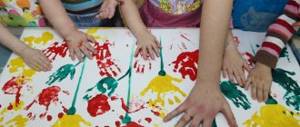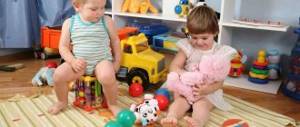Daily routine in kindergarten
Contents
“Russia is a generous soul!” — for some reason, this particular slogan, but with sarcasm, comes to mind when I think about the fact that paid parental leave lasts only 1.5 years out of a total of 3. That is why, in order to somehow survive, many mothers today try to send their children to nurseries, kindergartens and go to work early. Therefore, it is worth studying the daily routine in the kindergarten and nursery group in advance!
We were very lucky with the kindergarten, and this robber in a dress quickly adapted
Unfortunately, fewer and fewer nursery groups are opening in kindergartens in our city, and throughout the country, from year to year, and they are increasingly taking them from the age of 2, and not from 1.5, as before. So if you are lucky and your child has waited his turn in the nursery, you should start preparing for a new stage of life for your baby at least a few weeks before the first day of kindergarten.
In general, my congratulations to the joyful mothers and my wishes for strength!! I myself managed to go to work, and even then not for the whole day, only on the third maternity leave. But we haven’t heard about the nursery; the mother is sitting with her daughter. By the way, I’ll tell you about that treasure trove of parental help in the following articles. By subscribing to updates, you will be the first to know about things that you and I never thought about before...
How to prepare your baby for kindergarten?
Kindergarten is a new, difficult, but important and interesting stage in the life of children. For a child who has previously only been with his mother all day long, the nursery becomes a colossal stress: his mother is not around, only someone else’s aunt and a bunch of other children. No home bed, no favorite toys, no usual routine. How can you help your child survive this stress?
This is how the child will make it clear to his mother about his attitude towards the idea of leaving him in kindergarten.
It is not clear for whom the greater test is - for the child or the mother - seeing your child cry and leaving the kindergarten is the height of the resilience of the mother’s psyche.
To begin with, try to at least accustom him in advance to the new regime in which he will have to live in kindergarten. Certainty is important for young children, which is why it is so important to have a clearly structured schedule, and it is also more convenient for the mother. Children are not yet oriented in time; they do not understand what it means in an hour, tomorrow or in a week. But children get used to the fact that after breakfast there will be a walk, and after bathing there will be a nap.
By the way, for the mother herself it is extremely convenient and useful to properly distribute her time. Someone will say:
“my child does not sleep during the day”,
"we are used to getting up late"
“we only swim in the morning”
and in general
“I don’t have time to do anything, let them suffer with him in kindergarten!!!”
True, true, I have heard such statements.
Let me return to the children - so that the transition from the usual daily routine to the standard kindergarten one does not become a shock for the child, try to gradually switch to the new routine at home, in a familiar environment. Then it will be easier for the child to wake up on time so as not to be late for kindergarten, go to bed at the same time every day, go for a walk, etc.
for some reason the children don’t obey at home, but in kindergarten they behave quite well
During walks, be sure to be with your child on the playgrounds, so that he not only gets used to a large number of other children next to him, but also slowly learns to communicate with them.
If possible, slowly teach your child to calmly stay with one of the close adults when mom is not around. This could be dad, grandma, aunt, nanny. For children who are inseparable from their mother, visiting kindergarten becomes much more stressful than for those who previously calmly tolerated the absence of their mother for several hours.
A big plus will be the child's ability to go to the potty. Of course, this is usually not one of the mandatory requirements when admitting a baby to a nursery group, and he may well be potty trained right there, in the nursery. But, believe me, if your child makes friends with the potty at home, it will be easier for him and you will be calmer.
And, of course, it’s worth teaching your child to clean up his toys. This skill will also be very useful for him to better adapt to the rules of kindergarten. And this problem is very common among kindergarteners - often it is precisely because of the strict requirement for order that children do not like kindergarten(.
I would also like to offer you a video of the favorite national pediatrician E.O. Komarovsky. Surely you have already heard about it!
Standard daily routine in a nursery group.
A little higher, I advised you to instill in your child in advance the new daily routine that awaits him in kindergarten. What does he look like? Visually, it may seem quite rigid, however, in kindergarten, in the process of related and subsequent actions and under the guidance of specialists, the daily routine is playful!
So, you need to bring your child to the group before 8 am. Each kindergarten has its own rules: somewhere after 7:15 they no longer accept children, somewhere at 7:45 you can still drop them off. But at 8 am there is usually morning exercise, after which the children sit down to have breakfast. But did we usually arrive later than 8 o’clock ?
From approximately 8:40 to 9:10 children have free time, and at 9:10-9:20 and 9:20-9:30 various general education classes are held, including rhythm, music, physical education, and game-based learning of the basics of mathematics , drawing or other creative activities.
At 9:30 the teacher takes the kids out for a morning walk. Not all nurseries offer outside time in their nursery group, so there may well be group play time instead.
11:30-12:00 – lunch, then quiet time. 15:00 – 15:30 – awakening from daytime sleep, hygiene procedures (including pottying), warm-up. 15:30 – light afternoon snack, after which free time for group games. 16:45 – dinner. 17:15 – evening walk.
You can also draw something similar at home
Difficult period of adaptation. Useful tips.
Adaptation to kindergarten is a lot of stress for any child, so you can’t leave your baby there all day at once. The process of getting used to kindergarten should be smooth. Usually, babies are taken to the nursery first for just 2 hours, in the morning. Gradually, the time spent in the group increases until lunch, then until waking up after a nap, and then you can leave the child for the whole day.
But how long it will take for the child to finally adapt to kindergarten depends not only on the child himself and his parents, but also on the situation in the kindergarten and the family as a whole. Some people get used to it more easily and after a week they stop crying when mom or dad leaves them in the garden. For other children, the adaptation process may take several months.
To make it easier for your child to adapt to changes in his life, he will need your help . He shouldn't have any fear that you're leaving him! Explain to your baby, leaving him in the nursery in the morning, that you will soon return for him, that you are not leaving for good, but only to work or to the store, that you love him very much and will miss him!
From experience and that of many mothers, my dears, I understand how difficult it is to watch our children cry; their hearts, as they say, can break. However
long and tearful goodbyes, a nervous mother who is late for work - the key to a difficult adjustment to a child care facility.
At the same time, of course, only the birth mother knows her child better than others!!
Typically, a baby’s adaptation to a nursery takes place in 4 stages:
- The child does not want to tear himself away from his mother. At this stage, it is better, if possible, to send your grandmother or father or another loved one to the garden. As usual, it is with the mother that the child feels all-permissive!
- The child begins to get used to the new environment and agrees to play on his own or with other children.
- The child plays alone more and more often and with great interest and tries to communicate with peers.
I also offer you a whole collection of original tests created by me personally, where you can at your leisure evaluate your ability to master the science of raising children). The collection is available after subscribing to blog news, which guarantees no spam, the subscription button is below the article and on the right, in the banner).
- The last stage of adaptation is when the child begins to calmly remain alone in the group and allows his mother to leave. However, before you actually leave, you need to let your child know when you will come for him: after lunch, after quiet time, or during an evening walk. This will give him some sense of certainty.
Moms, let's share in the comments stories about how you or your friends took your child to kindergarten . Maybe it was your mother who left you in kindergarten, and then you organized strikes?)) I think it will be fun to read about children’s and adults’ struggles for their own right to identify!))
Starting kindergarten is a difficult time in a child’s life. It is only in your power to try to relieve him of this stress as much as possible. Good luck!
mama-on-line.ru
Walks
The daily duration of children's walks is at least 4 - 4.5 hours.
The walk is organized 2 times a day: in the first half - before lunch and in the second half of the day - after a nap or before the children go home.
When the air temperature is below minus 15° C and the wind speed is more than 7 m/s, the duration of the walk is reduced. The walk is not carried out at an air temperature below minus 15° C and a wind speed of more than 15 m/s for children under 4 years old, and for children 5 - 7 years old at an air temperature below minus 20° C and a wind speed of more than 15 m/s.
Nursery garden
Mothers of children, especially those who need to go to work, are concerned about the question of how to send their child to the nursery group of a kindergarten. The realities of today are such that preparation for solving this issue should begin from the first days of a child’s birth, especially if we are talking about nurseries that are supported by the state.
How to arrange a child in a nursery?
Before directly addressing this issue, parents should decide on the institution itself, familiarize themselves with the program for children and the additional capabilities of the nursery.
In state kindergartens, members of the Kindergarten Enrollment Commission are responsible for recruiting groups. The corresponding application to the commission must be submitted in advance, preferably in the first month of the child’s birth, since there are not enough places in the kindergartens and the queue can be long. When the turn comes, parents are notified about this and kindergarten employees report on the list of documents that parents will need to prepare, as well as what the child will need in the nursery.
The procedure for admission to a paid nursery may differ, so once you have decided on a kindergarten, you will need to find out all the details from the manager.
What do you need to know about nurseries?
In addition to documentary formalities, the child’s parents should familiarize themselves with such important things as:
- menu in the nursery;
- daily routine in the nursery;
- classes in the nursery.
The menu for a child is of great importance, since the nutrition of a growing body must be healthy and balanced. Food should not be greasy; dishes should include vegetables and fruits. The distribution of calorie content of dishes should also be in accordance with the standards. So, 25% each falls on breakfast and dinner, 35-40% on lunch and 10-15% on afternoon tea.
Classes in the nursery include not only discipline, but also the development of the child, both mentally and physically. In addition to developmental programs, nurseries should have physical education classes and compulsory walks in the fresh air. You should definitely ask about the daily routine, since the child will need to be accustomed to the same daily routine in advance. Thus, the child’s adaptation to the nursery will be much easier. After all, very often a child cries in a nursery, due to the fact that educators have to accustom him to general requirements at an accelerated pace. This can cause him additional stress and ultimately result in illness.
At what age are they admitted to the nursery?
In state kindergartens, children who have reached 1.5 years of age are accepted into the nursery group. As a rule, the condition for admission to a nursery group is the child’s ability to ask and go to the potty and eat on his own.
Private nurseries have the advantage that the age threshold is significantly reduced; sometimes they take children under one year old, which completely depends on the kindergarten itself. The requirements for what a child needs to be able to do in a nursery also vary, depending on the age group and the professionalism of the kindergarten workers.
Nursery teacher
According to the requirements, the responsibilities of a nursery teacher include:
- ensuring the life safety of the children entrusted to him;
- formation of perseverance and hard work in children, by accustoming them to routine moments and discipline;
- finding contact with children and their parents;
- notifying parents about the child’s behavior, possible problematic issues, and involving them in parenting;
- organization of children's leisure;
- conducting classes within the framework of approved educational and educational programs.
A teacher working with children in nursery groups must undergo medical courses or have an appropriate secondary specialized education.
womanadvice.ru
Meeting children and morning routine moments
Children are accepted into the garden in a group area or indoors during the cold season. At this time, the teacher’s task is to provide a positive charge to the child for the whole day through play or to interest him in carrying out certain actions in the labor sense. Together with the children, they prepare for classes, wipe dust from toys, do independent activities, read literature or other activities planned by the teacher for that day.
The daily routine in the preparatory group according to the Federal State Educational Standard in the morning hours, from 7.00 to 10.30, provides children with mental stress to fully absorb the material in class.
The morning routine also includes mandatory morning exercises, which starts at 8.00. Gymnastics in the preparatory group lasts at least 20 minutes and activates the child’s entire muscular system, which has a positive effect on overall well-being. In addition to exercises, the teacher can perform a corrective or acupressure massage and show children the advantages of physical activity.
What types of groups are there in kindergarten?
Each preschool institution has a certain set of groups that differ not only in the age characteristics of the children, but also in their development, as well as the length of stay. The main groups of a traditional kindergarten are nursery, junior, middle, senior and preparatory. In addition, many kindergartens have speech therapy groups, enrollment in which is carried out at 4-5 years of age, after checking and testing children by a speech therapist. They are divided into groups ONR and FNR. ONR - speech therapy groups in kindergarten, intended for children with general speech impairment, FNR - for children with phonetic, that is, sound, speech impairment. In the summer, general summer groups are usually opened for children attending kindergarten during this period.
Nursery group in kindergarten
The nursery group of the kindergarten accepts the youngest pupils, that is, children who are going to kindergarten for the first time. Their age ranges from one year to two or three years. Such groups are usually located on the ground floor for the convenience of children; the furniture in the group corresponds to their height. Classes on speech development, music, and the environment are conducted in accordance with the plan. Classes are conducted by a teacher in a group and last no more than 10 minutes. Toys must also be age-appropriate - large cubes and pyramids, rubber animals and baby dolls, balls, cars, children's sand play sets, dolls, doll dishes, baby books - all without small and dangerous parts. The daily routine in the nursery group differs from that of older children: early breakfast, lunch, afternoon snack, dinner. Going to bed early for a quiet hour. There should be no more than 10-15 children in such a group. There must always be a nanny present to help dress and undress the babies, feed and wash them, and put them to bed. There is usually only one holiday in the nursery group - New Year, and it is also celebrated in the group.
Junior group in kindergarten
The younger group is attended by children aged three to four years. These are more independent children who know and can do a lot. Drawing, physical education and music classes with specialist teachers, drawing and modeling are added to the main classes. The duration of the lesson is 15 minutes. Children at this age love to play role-playing games, so group toys include various but simple children's sets for doctors, hairdressers, builders, cooks, as well as all kinds of construction sets with large parts and figures. Books for reading in a group should already have a long and detailed plot. There should also be books with riddles and simple coloring books with a simple silhouette or outline. In the younger group with children, in addition to celebrating the New Year, there is also a holiday dedicated to March 8th, and they take place in a large common hall. Many children at this age already speak well, so for performances at holidays they can be given poems and small roles to memorize together with their parents.
Middle group in kindergarten
The age of children in the middle group is from four to five years. They are already more physically developed and stronger; they can easily play outdoor games with sports equipment. Therefore, in the middle group of kindergarten it is necessary to conduct as many physical education activities as possible on the street. Classes such as mathematics, literacy, application, and logic are being introduced. Class duration is 20 minutes. You can enroll children in additional clubs - dance, English, arts and crafts, etc. Toys and games include cubes with complex patterns for making pictures, lotto and dominoes, educational board games, as well as glove toys for acting out theatrical scenes and fairy tales. Children can now not only listen to a fairy tale to the end, but also, having memorized the roles, show it to children of younger groups. “Autumn Festival” and “Spring Festival” are added to the main matinees.
Senior group in kindergarten
The senior group of the kindergarten is attended by children aged five to six years. Classes are already becoming more intense, in-depth and longer – 25 minutes each. Activities such as the history of the native land and handicraft skills are often introduced. Children can perform simple exercises from sports such as gymnastics, basketball and some others. The toys in the group should be varied and age-appropriate: mosaics, puzzles, three-dimensional construction sets with many details. Children are also taught housekeeping skills. Therefore, among the toys there should be miniature doll gas stoves, cutlery, an ironing board with a toy iron, brooms, dustpans and brooms. You can invite children to care for indoor flowers, aquarium fish, and parrots. “Christmas”, “Defender of the Fatherland Day”, “Easter”, “Victory Day” are added to holidays and matinees.
Preparatory group in kindergarten
The preparatory group of the kindergarten is attended by children aged six to seven years. For children, this is a very important, last, final stage before entering school. There are many developmental and educational activities: reading and mathematics, native speech and the world around us, music and physical education, manual labor and origami, modeling and drawing. The group often sets up easels and hangers with clothes from various professions for children’s story games. At this age, children are actively learning the rules of etiquette, as well as traffic rules. Matinees and holidays are complex and theatrical, children can even act as presenters. The graduation party at the end of the year is the most important for children and their parents, where graduates show all their abilities and talents.
Speech therapy group in kindergarten
Children are recruited into speech therapy groups by a speech therapist based on preliminary testing and thorough screening. The ONR group includes children with general speech disorders, the FNR group includes children with problems in pronouncing certain sounds. Pupils, in addition to the main classes, engage in special exercises with a speech therapist and teacher aimed at improving and improving their speech. In such groups there are usually not many children - 10-12 people. Classes with a speech therapist can be individual or group, and are conducted according to a schedule. All other classes are conducted according to a simplified and facilitated plan, acceptable for children with such defects.
Summer group in kindergarten
A summer group is usually a temporary group for the summer period, which is attended by children of different ages. There are usually no classes in the summer, but only outdoor games, reading books, going to puppet theaters or museums.
In any group of a preschool institution there must be two teachers and one nanny. The day should be organized strictly according to the regime established for each specific age, with games, walks, activities, and entertainment. Each lesson is held no more than 2 times a week.
Author of the article: Alla
www.rastut-goda.ru
Individual work
The second half of the day, from 15.40 to 17.00, in a preschool institution is aimed at consolidating the material studied in the morning, or repeating previously acquired knowledge. Individual work with children is aimed at improving speech, creative and motor activity.
A music director, speech therapist or teacher conducts individual work according to planning or seeing the child’s general poor performance. The preparatory group at the preschool educational institution, or rather the children attending it, undergo classes with a psychologist who corrects the mental abilities of each child.
Explain how a nursery differs from a kindergarten, except for the age of the child?
Nothing except that in nurseries children “go” to the potty and doctors used to work with such children, and there are toilets in the garden. And in winter they walk with them down to -15 degrees, don’t listen to nonsense. I am a teacher, I also worked in a nursery - please contact me if you need anything...
They differ in age; nurseries are the youngest group from 1.5 to 3 years. The kindergarten teacher has an education plan. Children in the nursery group play simpler games than children in older groups.
ONLY by age
In the nursery, the regime is more lenient, the children eat longer, spend more time sleeping, walk less, the classes are basically the same, but less time-consuming, and the children’s menu is slightly different from the kindergarten one.
A child in a nursery group will not be interested. My child goes to nursery. She is 2.5 years old. And almost everyone in the group is under 2 years old. They don't even know how to speak yet. She's interested in older kids
training and daily routine
Age, daily routine and the MANDATORY presence of a nanny or, as it is correctly called, an assistant teacher.
touch.otvet.mail.ru








